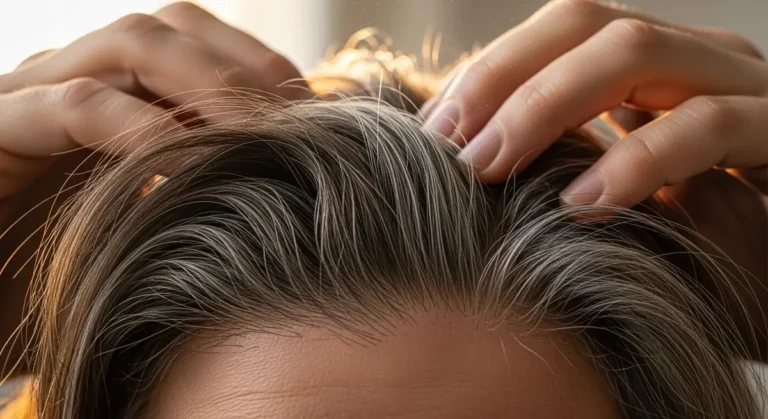“Scalp detox” has become a popular label for products promising to remove buildup, reset the scalp microbiome, and revive hair. But the phrase isn’t a standardized clinical term — it’s often marketing shorthand for clarifying shampoos, physical or chemical exfoliants, and adsorptive ingredients like charcoal or clay. This article separates hype from evidence by reviewing dermatology and cosmetic‑chemistry principles, summarizing current research on scalp microbiota, exfoliation, and clarifying products, and giving practical, science‑based guidance for readers considering a scalp “detox.”
Scalp detox: claims, common ingredients, and mechanisms

“Scalp detox” is a marketing shorthand that promises to remove buildup, restore a balanced scalp environment, and revive hair appearance. The phrase itself has no single clinical or regulatory definition; beneath the hype are a set of well‑established cosmetic‑chemistry and dermatological mechanisms. Translating those mechanisms into realistic expectations requires separating product categories and describing exactly what the active ingredients can — and cannot — remove.
Common marketing claims and what they imply
Manufacturers commonly describe scalp detoxes as able to “reset the scalp microbiome,” “remove greasy buildup,” “strip away silicones and residue,” or “detoxify pollutants.” Those claims mix plausible actions (removing surface oils and styling residues) with vague, poorly‑defined promises (“reset” the microbiome or “detoxify”) that are difficult to measure in a consistent clinical way. Dermatology and cosmetic chemistry evaluate these products by asking: which molecules or particles does the formulation remove, by what mechanism, and with what risk to the scalp barrier?
Clarifying shampoos — surfactants and chelators
Clarifying shampoos use one or more surfactants to solubilize and remove lipids, oils, silicones, and water‑insoluble styling polymers. Surfactants form micelles that encapsulate nonpolar residues and allow them to be rinsed away. Common surfactant families include anionic sulfates (strong detergency), anionic sulfonates, and milder amphoteric or nonionic surfactants. A stronger anionic surfactant will remove resilient residues more effectively, but at a higher risk of stripping natural lipids and causing dryness or irritation.
Chelating agents (for example, EDTA derivatives or weaker organic acids) are often included to bind divalent metal ions such as calcium and magnesium from hard water. Metals can interact with anionic surfactants, reduce foam, and leave mineral films; chelators improve rinsing and reduce mineral‑related buildup. pH modifiers (citric acid, sodium citrate) also influence surfactant performance and can help dissolve mineral scale.
Mechanistic summary: surfactants emulsify and solubilize sebum, oils, and many silicone polymers; chelators complex metal ions that otherwise precipitate or form films.
Physical scrubs and mechanical exfoliation
Physical exfoliants for the scalp use particulate abrasives (sugar, salt, cellulose beads, jojoba esters) or soft brushes to remove adherent corneocytes and deposited styling residues. Mechanical action dislodges flakes and thick product films that surfactants alone may not remove quickly.
Mechanical removal is effective when performed gently and infrequently. Excessive abrasive scrubbing or hard particles can abrade the stratum corneum of the scalp, disrupt barrier lipids, and trigger inflammation or microinjury — which may worsen flaking or predispose to irritation and infection.
Chemical exfoliants — AHAs and BHAs
Alpha hydroxy acids (AHAs, e.g., glycolic, lactic acid) act primarily on the cohesion between corneocytes by lowering intercellular adhesion and promoting desquamation. AHAs are water‑soluble and tend to act on the surface. Beta hydroxy acids (BHAs), chiefly salicylic acid, are lipophilic and penetrate into sebum‑rich follicular openings, where they can dissolve lipid‑rich plugs and reduce follicular scaling.
Key formulation considerations: concentration and vehicle determine efficacy and irritation risk; pH controls AHA activity; salicylic acid efficacy depends on adequate contact time and solubility in the chosen base. On the scalp, lower concentrations and shorter contact times are generally advised to minimize irritation.
Adsorptive agents — charcoal and clays
Activated charcoal and clays (kaolin, bentonite) are used for their high surface area and sorptive properties. They bind nonpolar molecules, pigments, and small particles through a combination of hydrophobic interactions, van der Waals forces, and electrostatic attraction. Clays also swell and can absorb free oils from the surface.
Practical limits: adsorption is a surface phenomenon — particle size, contact time, and dispersion in the formula determine how much residue is captured and removed during rinsing. Claims of “deep detox” should be interpreted as enhancing removal of surface oils and particulate deposits rather than a biological detoxification of living tissue.
What these ingredients actually remove
- Sebum and free lipids from the skin surface and hair shafts
- Water‑insoluble oils and natural or added oils (e.g., coconut oil, styling oils)
- Many silicones and some film‑forming polymers (effectiveness depends on polymer chemistry and surfactant strength)
- Mineral deposits from hard water (aided by chelators)
- Product residues such as waxes, heavy conditioners, and spray polymers
- Adherent dead skin cells and scales (mechanical or keratolytic removal)
They are less effective or irrelevant for:
- Literally “detoxifying” systemic toxins or altering internal physiology — cosmetics act at the skin surface
- Permanently eradicating a microbial community in a beneficial way; transient reductions in surface microbes do not equal a healthy, controlled reshaping of the microbiome
Safety, limitations, and interpretive caution
The functional actions described above are supported by cosmetic‑chemistry principles and dermatologic reasoning, but branded “scalp detox” protocols are rarely validated by robust clinical trials that measure long‑term scalp health or microbiome outcomes. Repeated use of aggressive surfactants, frequent mechanical abrasion, or high‑concentration chemical exfoliants can strip protective lipids, increase transepidermal water loss, and provoke irritation or rebound oiliness.
In clinical terms, the more realistic goal of these products is temporary removal of superficial buildup and improved tactile and visual hair qualities. Claims that a single product will “reset” the microbiome or provide a durable medical cure exceed what topical cleansing and adsorption can reliably deliver.
Translating mechanism into practical expectations
When a consumer chooses a clarifying or detox product, they should expect measurable removal of oils, silicones, and product films when the formulation contains sufficiently active surfactants, appropriate chelators, or adsorptive clays/charcoals and when the product is used with adequate contact time and rinsing. For targeted reduction of follicular plugs and flaking, BHAs or gentle keratolytics can help. For thick mineral or product films, a surfactant‑plus‑chelator combination is often the most effective.
Overall, ingredient selection and application technique determine outcomes more than the marketing label “detox.” Matching strength to scalp sensitivity — and avoiding frequent, aggressive treatment — preserves barrier function while achieving the cosmetic benefits of clearer, residue‑free hair and scalp.
What the research and dermatology say: microbiome, exfoliation, and clarifying shampoos

The scalp is an ecosystem where lipids, corneocytes, hair follicles and a dense microbial community interact to maintain barrier function and local immune tone. Dominant residents include lipophilic fungi (especially Malassezia species) and bacteria such as Cutibacterium and Staphylococcus species; their relative abundance—and the composition of sebum they metabolize—helps determine whether the scalp remains calm or progresses toward flaking and inflammation. Microbial metabolic activity (for example, Malassezia lipases releasing free fatty acids) and host responses (antimicrobial peptides, innate immune receptors) are central mechanistic explanations for common conditions such as dandruff and seborrheic dermatitis.
Regular cleansing has a straightforward, evidence‑based role in that ecosystem: surfactant‑based shampoos remove excess sebum, silicone residues and styling products that would otherwise alter the local environment and encourage accumulation of keratinous scale. Clarifying shampoos typically combine detergents (surfactants), sometimes stronger anionic agents like sodium lauryl sulfate (SLS) or sodium laureth sulfate (SLES), with chelators such as EDTA that bind metal ions and improve rinse‑out of insoluble residues. Physical scrubs and mechanical massage remove loosely adherent scale; chemical exfoliants—principally salicylic acid (a lipid‑soluble BHA) and alpha‑hydroxy acids like glycolic acid—accelerate desquamation and can penetrate sebum‑rich plugs more effectively than hydrophilic agents.
Two important caveats emerge from dermatology and cosmetic‑chemistry literature. First, the phrase “scalp detox” is not a standardized medical term: it is marketing shorthand that bundles disparate mechanisms (surfactant cleansing, adsorption by clays or charcoal, mechanical removal, keratolysis) into a single promise. Second, randomized, high‑quality clinical trials that test branded “detox” protocols head‑to‑head with standard care are limited. Most controlled evidence pertains to targeted interventions—antifungal agents for seborrheic dermatitis, keratolytic acids for hyperkeratosis, and controlled use of clarifying shampoos for residue removal—rather than omnibus detox regimens sold as a lifestyle cure.
Where the reviews converge, however, is instructive. Systematic and narrative reviews emphasize that occasional, targeted removal of buildup can improve scalp comfort and reduce visible scale without destabilizing the ecosystem. Salicylic acid’s lipophilicity and keratolytic action make it a logical choice for reducing scale; chelators and stronger surfactants are effective at removing non‑lipid residues such as hard water precipitates or silicones. Adsorptive ingredients (activated charcoal, bentonite clay) can transiently remove oil and particulate matter by adsorption, but evidence that they meaningfully “reset” microbial communities is sparse and largely inferential.
The primary risk is over‑enthusiastic cleansing. Repeated use of harsh surfactants or frequent aggressive mechanical exfoliation can strip natural lipids, increase transepidermal water loss (TEWL), disrupt the stratum corneum and upregulate inflammatory pathways. Clinically this presents as tightness, erythema, increased flaking or paradoxical worsening of pruritus. Barrier disruption can also change the microenvironment in ways that favour opportunistic organisms; for that reason, gentle modulation of the scalp is preferable to routine, aggressive detoxing. Reports from formulation science and dermatology reviews recommend avoiding routine daily use of high‑strength anionic surfactants and favoring milder surfactant blends, buffered pH, and well‑formulated leave‑on or rinse‑off keratolytics when exfoliation is needed.
Practical interpretation of the evidence supports a balanced message: cleansing and occasional, gentle exfoliation are reasonable tools to manage buildup and relieve symptoms associated with excess sebum or product residue. However, the marketed promise that a single detoxing session will “reset” the microbiome or cure chronic scalp disease goes beyond the level of direct clinical proof. For readers who want to explore the science behind how microbial communities influence barrier health and treatment choices, a primer on the underlying skin microbiome principles can be helpful for putting product claims in context: principles of the skin microbiome.
In summary, dermatology and cosmetic‑chemistry evidence favors evidence‑based, individualized strategies: use clarifying agents and keratolytics selectively to remove buildup; prefer gentler surfactants and controlled‑strength exfoliants; monitor for signs of barrier compromise; and seek professional evaluation when flaking, inflammation or itching are persistent or severe. Occasional, targeted removal of residue and scale aligns with current review findings, whereas routine aggressive detoxing carries a realistic risk of barrier disruption and symptom exacerbation.
Evidence‑based routine: when to use exfoliation and clarifying shampoo safely

Assessing whether your scalp needs a targeted cleanse or exfoliation starts with careful observation and a simple skin‑care approach: identify scalp type, characterize the buildup, and match that profile to an intervention that removes residues without disrupting barrier function or the microbial community that lives on skin.
Scalp type and signs of buildup
- Oily scalp: visible grease within a day or two of washing, hair that lies flat or clumps, and a scalp that feels slick to the touch. Oily scalps are more prone to seborrhea and respond to stronger cleansing when needed.
- Dry, sensitive scalp: tightness, fine flaking, persistent dryness, or a history of dermatitis. These scalps tolerate aggressive cleanses poorly and benefit from gentler approaches.
- Flaky or inflamed scalp: large-scale, persistent flakes, intense itching, redness or crusting—these signs suggest a dermatologic condition (e.g., seborrheic dermatitis, psoriasis) where routine “detox” is not the first-line solution.
- Product buildup or hard‑water residue: hair looks dull, is slow to lather, or feels coated (silicone-containing products, heavy oils, mineral deposits). Users of styling waxes, heavy leave-ins, or frequent dry‑shampoo use commonly have this pattern.
Choosing a clarifying shampoo or exfoliant: chemistry and practical selection
- Surfactant strength and type: look for formulas that balance cleansing power with gentleness. Avoid leaving‑formulation products that rely on sodium lauryl sulfate (SLS) as the primary surfactant when you have a sensitive scalp; SLS is an effective cleanser but more likely to irritate. Milder anionic or amphoteric surfactants (for example, sodium laureth sulfate in lower concentrations, sodium C14‑16 olefin sulfonate, amphoteric coco‑betaine) or nonionic surfactants (decyl glucoside) can clean effectively with less irritation.
- pH considerations: healthy scalp skin is mildly acidic. Extremely low‑pH products or repeated acid peels can disrupt barrier lipids; choose products formulated for scalp use that list a near‑physiological pH on the label or are described as scalp‑gentle.
- Chelators and mineral removal: ingredients such as EDTA or mild acids (citric acid) help remove metal‑ion or mineral deposits from hard water and reduce residue from styling products.
- Adsorptive agents (charcoal, clays): these can remove oils and particulates superficially. They are useful for temporary removal of grease or visible residue but do not “reset” the microbiome in any validated clinical sense.
- Chemical exfoliants: salicylic acid (a BHA) is lipophilic and penetrates sebum, making it the most evidence‑consistent choice for follicular desquamation and oily, flaky scalps. OTC concentrations commonly range from 0.5–2% and are often included in rinse‑off or leave‑on scalp products. AHAs like glycolic or lactic acid target surface corneocytes and can help with scale but may be more irritating on inflamed skin.
- Physical exfoliants: scrubs or scalp brushes can remove visible flakes and product residue. Use with caution on inflamed or thin scalps; abrasion can worsen barrier damage.
Frequency and dosing guidelines (evidence‑guided, conservative approach)
- Clarifying shampoo: for most people who use heavy styling products, once every 1–2 weeks is a reasonable starting point; for those with oily scalps or frequent product use, once weekly may be appropriate. Avoid daily clarifying shampooing unless recommended by a professional.
- Chemical exfoliation (BHA/AHA): start with a low‑frequency protocol—once every 7–14 days—while monitoring tolerance. If a product is leave‑on, perform a patch test and increase frequency slowly. Avoid combining multiple strong acids and avoid concurrent use with potent topical retinoids or physical abrasion.
- Physical exfoliation: limit to once every 1–2 weeks and avoid forceful scrubbing. A 30–60 second, gentle circular massage with fingertips or a soft brush is usually sufficient.
Step‑by‑step application protocol
- Prewash: rinse hair thoroughly with warm (not hot) water to hydrate residue and open superficial sebum films.
- Apply clarifying shampoo concentrated on the scalp, not the lengths. Use a coin‑sized amount for most scalps and distribute with fingertips.
- Lather gently for 30–90 seconds. If the product is designed to be left on (some chelating shampoos indicate a brief dwell time), follow label guidance—generally 1–3 minutes is sufficient to chelate minerals without overexposure.
- For chemical exfoliants: follow the product’s instructions precisely. If it is a rinse‑off formulation containing salicylic acid, massage for 30–60 seconds and rinse. For leave‑on acids, patch test first, start with once weekly, and rinse if irritation occurs.
- Rinse thoroughly, then complete with a conditioner applied to hair lengths (avoid heavy conditioners on the scalp if oiliness is the issue).
- Limit heat styling and manipulative trauma for 48 hours after exfoliation to allow recovery.
Recognizing red flags and when to stop
- Immediate burning, stinging, or sharp pain during application — stop, rinse thoroughly, and do not reapply the product.
- New or worsening erythema, swelling, or persistent itching after 24–48 hours — discontinue treatment and seek professional advice.
- Increased flakes or worsening hair fragility following repeated exfoliation — may indicate barrier impairment; pause exfoliation and switch to gentler cleansing for several weeks.
Alternatives and escalation paths
- Adjust product use: reduce silicone‑heavy leave‑ins, switch to lighter, water‑soluble styling products, or dilute dry‑shampoo use. Improved daily cleansing with a mild, sulfate‑free shampoo can obviate frequent clarifying treatments.
- Chelation rinse for hard water: a short citric‑acid rinse (formulated product) can reduce mineral buildup when hard water is the culprit.
- Prescription‑level care: persistent flaky, inflamed scalps that do not respond to conservative measures may require medicated antifungal shampoos (ketoconazole), topical corticosteroids, or other prescription agents aimed at seborrheic dermatitis or psoriasis.
When to seek a dermatological evaluation
Refer to a dermatologist when there is: widespread, persistent scaling not responsive to 4–6 weeks of conservative care; hair loss associated with scaling or broken hairs; severe itching or pain; signs of secondary infection (oozing, crusting); or when you need clarifying but also suspect an inflammatory scalp condition. A clinical assessment differentiates cosmetic buildup from dermatoses that require targeted medical therapy.
Practical bottom line
Use clarifying shampoos and exfoliants selectively: they are tools to remove sebum, silicones, and product residue when those are the primary problem, and salicylic acid–based chemical exfoliants are the best supported for oily, flaky scalps. Prioritize gentleness—match surfactant strength and acid concentrations to scalp sensitivity, limit frequency, watch for signs of barrier disruption, and escalate to dermatologic care when symptoms suggest an underlying disease rather than cosmetic buildup.
Conclusion
The concept of a “scalp detox” blends plausible cosmetic‑chemistry mechanisms with persuasive marketing language. While clarifying shampoos, gentle mechanical or chemical exfoliation, and adsorptive ingredients can remove sebum, silicones, and product residues, robust clinical trials specifically validating branded “detox” protocols are limited. The safest approach is an individualized, gentle routine guided by scalp type and dermatological advice: occasional targeted cleansing rather than frequent aggressive detoxing.
Want to dig deeper into the science behind scalp health? Read about scalp health science at Explore scalp health science.



